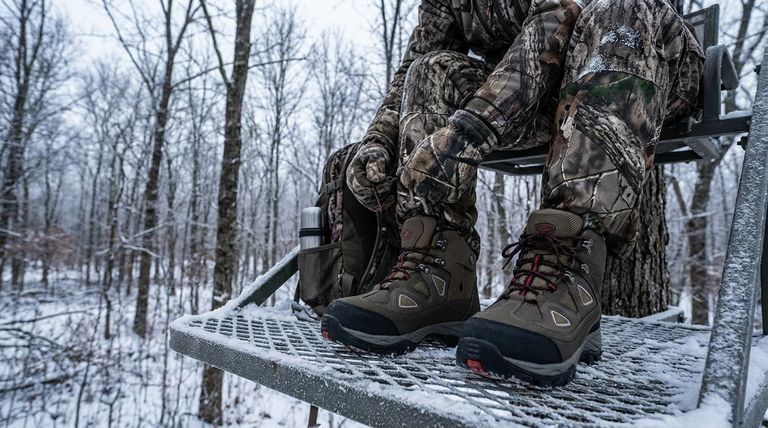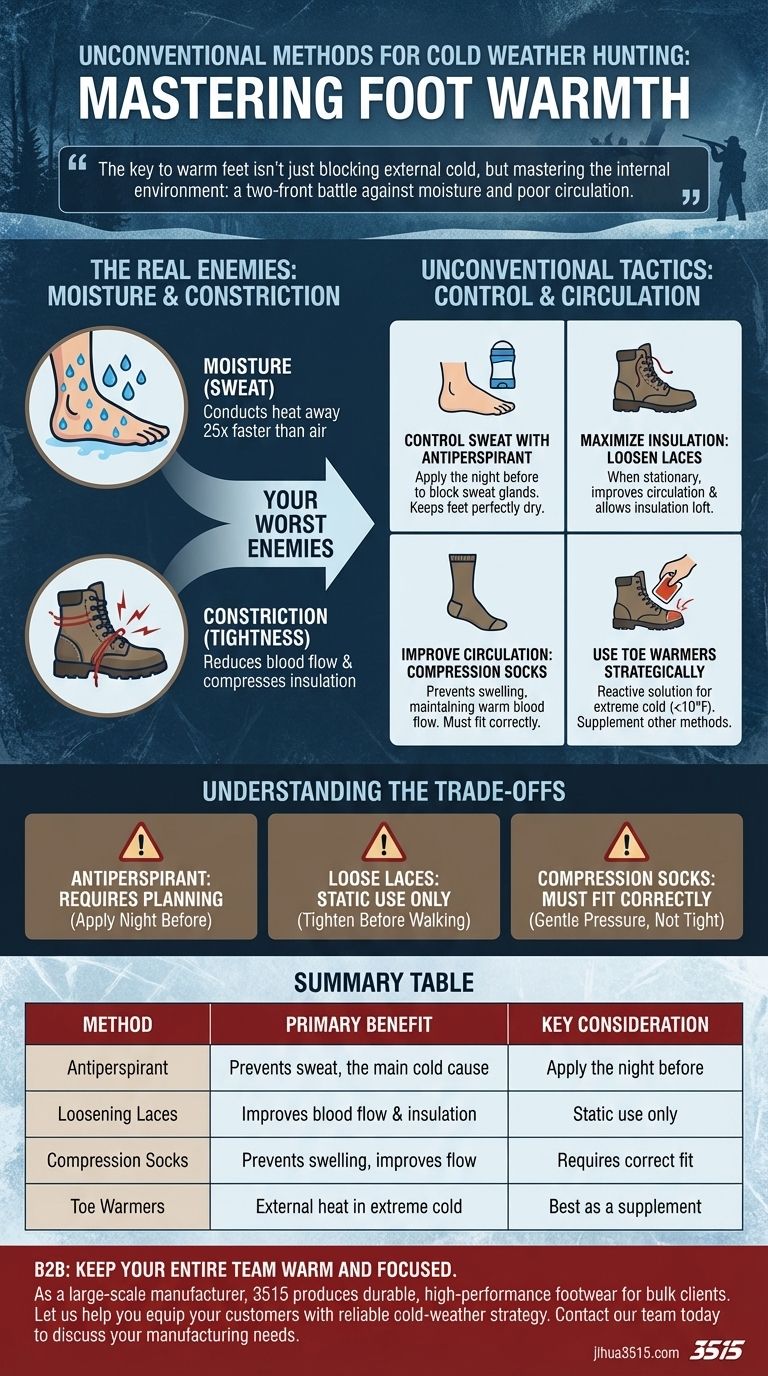Beyond better boots, the most effective unconventional methods for keeping your feet warm during cold weather hunting focus on managing moisture and circulation. These include applying antiperspirant to your feet to stop sweat before it starts, loosening your boot laces when stationary to improve blood flow, and wearing compression socks to prevent swelling.
The key to warm feet isn't just blocking external cold, but mastering the internal environment. The true challenge is a two-front battle against sweat-induced moisture from the inside and poor circulation caused by constriction.

The Real Enemies of Warm Feet: Moisture and Constriction
Before applying any tactic, you must understand the two primary reasons your feet get cold, even in high-quality gear. Addressing these root causes is what separates a comfortable hunt from a miserable one.
Why Moisture is Your Worst Enemy
Sweat is the fastest way to get cold feet. Water conducts heat away from your body up to 25 times faster than air.
Even a small amount of moisture inside your socks and boots will rapidly rob your feet of warmth, creating a damp, chilling effect that no amount of insulation can overcome.
The Problem with Constriction
Your body keeps your feet warm by sending them a steady supply of warm blood. Anything that restricts this flow is a significant problem.
Tightly laced boots not only reduce blood circulation but also compress the insulation, reducing its "loft" and its ability to trap warm air. Swelling over a long day can make this even worse.
Unconventional Tactics for Total Foot Warmth
These methods are designed to directly combat the core problems of internal moisture and restricted blood flow.
Control Sweat with Antiperspirant
The single most effective proactive step is to stop sweat before it starts.
Apply a standard antiperspirant to the bottom of your feet and between your toes the night before your hunt. This allows it to dry completely and block sweat glands, keeping your socks and boot interior perfectly dry.
Maximize Insulation by Loosening Laces
Once you are settled in your stand or blind and will be stationary for a long period, loosen your boot laces.
This simple action does two critical things: it improves blood circulation to your toes and allows the boot's insulation to decompress and trap more air, maximizing its effectiveness. Remember to tighten them again before you start walking.
Improve Circulation with Compression Socks
This may seem counterintuitive, but light compression socks can be a powerful tool.
Their purpose isn't to squeeze your feet but to prevent blood from pooling and your feet from swelling over a long, static sit. By preventing swelling, they prevent the constriction that chokes off warm blood flow.
Use Toe Warmers Strategically
Chemical toe warmers have their place, but they are a reactive solution, not a preventative one.
Reserve them for extremely cold days, typically 10°F or below. They work best as a supplement to the other methods, providing an external heat source when conditions are at their most severe.
Understanding the Trade-offs
Each of these methods has specific considerations for its use. Being aware of them ensures you get the maximum benefit without unintended consequences.
Antiperspirant Requires Planning
This is not a trick you can use in the field. Applying antiperspirant must be done the night before to give it time to dry and work effectively.
Loosening Laces is for Static Use Only
This tactic is exclusively for when you are sitting still. Walking with loose boots can cause blisters and reduces ankle support, increasing the risk of injury.
Compression Socks Must Fit Correctly
The goal is gentle, uniform pressure, not strangulation. Socks that are too tight will do more harm than good by directly restricting circulation. Ensure you have the proper size for your feet and calves.
Making the Right Choice for Your Hunt
Integrate these tactics into your existing system of quality boots and wool socks to create a comprehensive warmth strategy.
- If your primary focus is preventing cold before it starts: The antiperspirant method is the most powerful and proactive step you can take.
- If your primary focus is staying warm during long, stationary sits: Loosening your boot laces once you are settled is the easiest and most immediate way to improve warmth and comfort.
- If your primary focus is combating extreme, bitter cold: Combine all methods, using toe warmers as a final boost to an already solid foundation of moisture and circulation management.
By taking control of these internal factors, you can ensure your feet remain warm and comfortable, no matter what the external conditions are.
Summary Table:
| Method | Primary Benefit | Key Consideration |
|---|---|---|
| Antiperspirant on Feet | Prevents sweat, the main cause of cold feet | Must be applied the night before the hunt |
| Loosening Boot Laces | Improves blood flow and maximizes insulation loft | For use only when stationary; tighten before walking |
| Wearing Compression Socks | Prevents swelling that restricts circulation | Requires a correct, gentle fit to be effective |
| Strategic Toe Warmer Use | Provides external heat in extreme cold (<10°F) | Best used as a supplement to other methods |
Keep Your Entire Team Warm and Focused
As a large-scale manufacturer, 3515 produces a comprehensive range of durable, high-performance footwear for distributors, brand owners, and bulk clients. Our production capabilities encompass all types of hunting boots and insulated work boots designed to withstand the toughest conditions.
Let us help you equip your customers with reliable footwear that forms the foundation of a successful cold-weather strategy. Contact our team today to discuss your manufacturing needs and explore our full catalog.
Visual Guide

Related Products
- Safety Footwear Wholesale Manufacturer for Custom OEM/ODM Production
- High Performance Fire-Retardant Waterproof Safety Boots
- Factory-Direct Wholesale Canvas Boots with High-Traction Rubber Soles
- Factory Direct Wholesale Rain Boots Durable Waterproof & Fully Customizable
- Durable Spiked Camouflage Boots Wholesale & Factory Production
People Also Ask
- Is it normal to wear shoes in the house? A Guide to Hygiene, Comfort & Culture
- How long can you wear safety boots? The Lifespan is Determined by Wear, Not Time
- What are the differences between steel toe, composite toe, and alloy toe Wellington boots? Choose the Right Safety Toe for Your Job
- How do safety shoes contribute to cost savings for companies? A Strategic Investment in Risk and Cost Management
- What do heavy duty boots do? Protect Your Feet in Demanding Work Environments



















